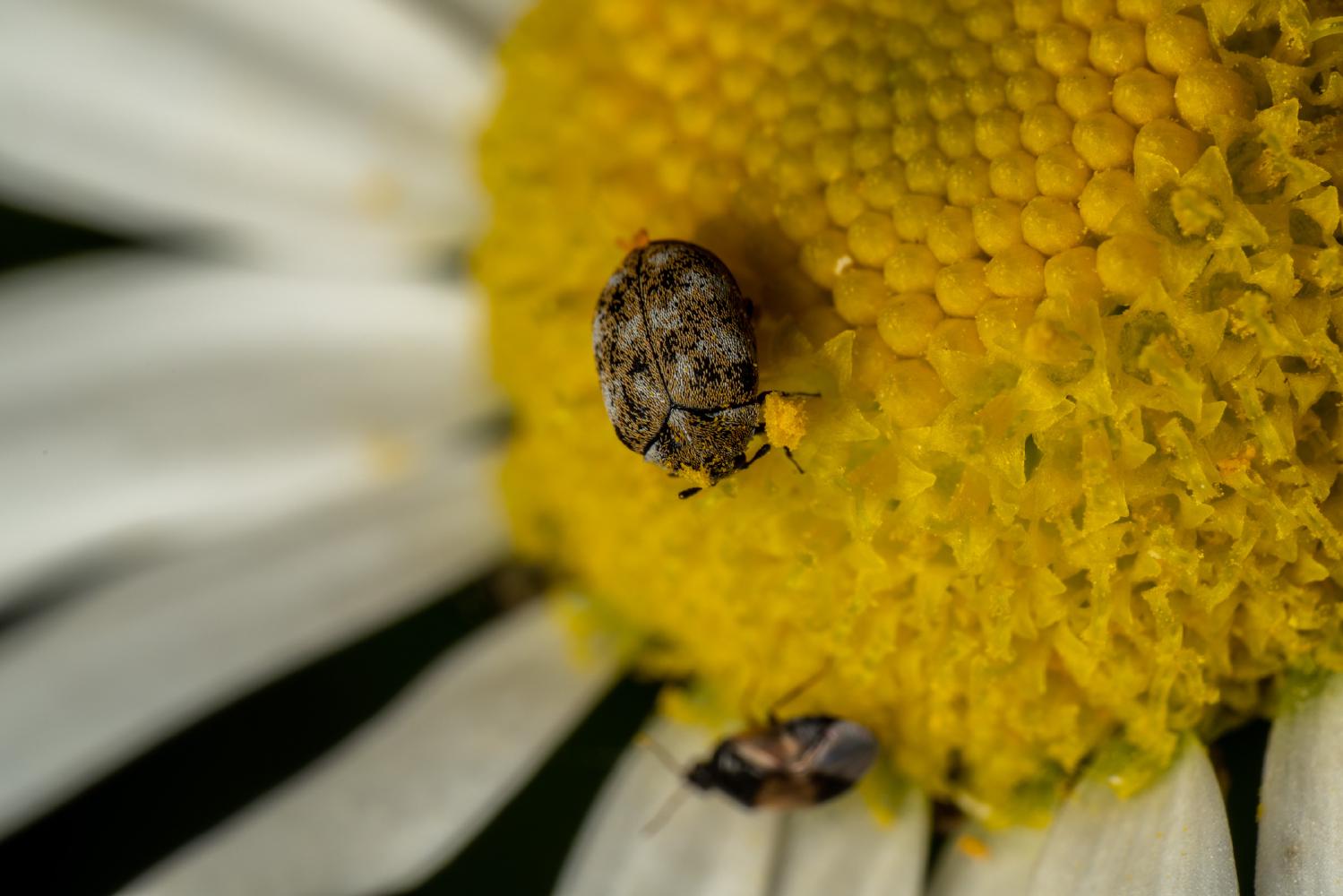Skin Beetles
Lat. “Dermestidae“
family
of order
“Beetles“
1 family, 4 species
Dermestidae are small beetles known for their distinctive and colorful patterns. They have rounded to oval shapes and hairy or scaly elytra. Larval Dermestidae have tufts of long, dense hairs and some have barbed setae for defense. They are typically found feeding on dry organic items and can be found on animal carcasses in natural habitats. Adult dermestids feed on pollen and nectar and are cannibalistic. The family has a long evolutionary history, with the oldest known member dating back to the Middle Jurassic. There are 74 genera within Dermestidae.
Hierarchy
Description
Adult Dermestidae are generally small beetles (1–12 mm long), rounded to oval in shape, with hairy or scaly elytra that may form distinctive and colourful patterns. Except in genera Dermestes and Trichelodes, there is a single ocellus in the middle of the head. The antennae are clubbed (except in male Thylodrias contractus) and usually fit into a groove on the underside of the thorax, concealing them when the beetle is at rest. Adult females of T. contractus are notable for being larviform, meaning they retain a larval morphology even into adulthood.Larval Dermestidae range from 5 to 15 mm long and are usually covered in tufts of long, dense hairs (setae). In subfamily Megatominae and the genus Trinodes, some of these setae are hastisetae: barbed setae ending in spear-like heads (hasta being the Latin word for “spear”). Hastisetae serve a defensive role, detaching and entangling predators.Pupae of subfamilies Dermestinae and Attageninae are covered in structures known as gin-traps, as defense against predators. Pupae of Megatominae are protected within the exuviae of the last larval instar.
Diet and behaviour
Dermestid larvae are typically found on dry organic items that are hard for other organisms to digest, such as dried foodstuffs, skins, hides, wood and other natural fibers. In forensic studies, the larvae are found on human corpses during the dry and skeletal phases of decomposition, which occurs several days after death. Larvae also move away from light and often hide in any cavity in order to remain undisturbed. In natural habitats, they can be found on animal carcasses, under bark, and in the webs, nests and burrows of various animals.Larvae of subfamilies Dermestinae and Attageninae (which lack hastisetae), burrow into feeding substrates, pupate in concealed locations, and show fast escape behaviours when disturbed. Larvae of Megatominae (which have hastisetae), do not burrow, pupate where they have been feeding, and their response to disturbance is to stop moving, arch the body and spread the hastisetae. This difference may be because hastisetae would be a hindrance for burrowing larvae.Adult dermestids are known to feed on pollen and nectar. Adults of Dermestes are cannibalistic and will eat young larvae and pupae; this means that when kept in captivity, adults should be placed in separate containers from the immature stages.
Evolution
While possible members of the family have been described from the Late Triassic and Early Jurassic based on isolated elytra, the oldest known unambiguous member of the family is Paradermestes from the Middle Jurassic Jiulongshan Formation of China, which appears to belong to the subfamily Dermestinae. Members of the subfamilies Attageninae and Megatominae are known from the Cretaceous, including the living genera Attagenus and Megatoma. The ancestral ecology of the group was likely mycophagy, which is retained in Orphilinae, with the ancestor of most other lineages making the transition to saprophagy.
Genera
Dermestidae contains the following 74 genera:
Further reading
John M. Kingsolver, “Dermestidae”, in Ross H. Arnett Jr. and Michael C. Thomas, American Beetles (CRC Press, 2002), vol. 2. This article incorporates text from a publication now in the public domain: Ward, Artemas (1911). The Grocer’s Encyclopedia. {{cite encyclopedia}}: Missing or empty |title= (help) Pasquerault, T Vincent, B, Chauvet, B, Dourel, L, and Gaudry, E (2008). Répartition des espèces du genre Dermestes L. 1758 récoltés sur des cadavres humains (Coleoptera Dermestidae). L’entomologiste Tome 64 N°4 pp 221–224. Hinton, H.E., 1945 A monograph of the beetles associated with stored products. 1, 387–395 British Museum (Natural History), London. Keys to world adults and larvae, genera and species; excellent figures, full species information. Freude, H.; Harde, K.W.; Lohse, G.A., 1979 Dermestidae. Die Käfer Mitteleuropas 6: Diversicornia (Lycidae — Byrrhidae) 1206 text figs. 367pp. Goecke & Evers. Text in German; the Dermestidae are on pages 304–327.
External links
List of North American Species Dermestidae-Literature Russian Atlas of Carpet Beetles-excellent images USDA Leaflet on Carpet beetles on the UF / IFAS Featured Creatures Web site Anthrenus flavipes, furniture carpet beetle Anthrenus scrophulariae, common carpet beetle Dermestes atar, black larder beetle Dermestes maculatus, hide beetle Stored Product Protection, Kansas State University
Ancestry Graph
Further Information
Copyright

This article uses material from the Wikipedia article Dermestidae the free encyclopedia Wikipedia which is released under Creative Commons Attribution-ShareAlike 4.0 International License). On Wikipedia a list of authors is available.
